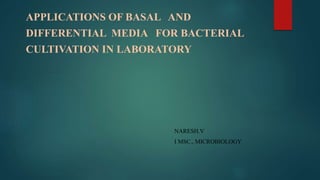
Bacteriology (application of basal and differential media)- Naresh velu , periyar University , dep of microbiology
- 1. APPLICATIONS OF BASAL AND DIFFERENTIAL MEDIA FOR BACTERIAL CULTIVATION IN LABORATORY NARESH.V I MSC., MICROBIOLOGY
- 3. Basal media Basal media are the otherwise known as simple media , which is widely used in laboratories to grow the bacteria. This media consists of almost all nutrient for non fastidious bacterial cultivation in laboratory (artificial condition). Nutrient like carbon, nitrogen, vitamins, minerals, and some other trace elements. Basal media is composed of without any extra or enriching material likes blood , serum, tissue, indicator, etc... These basal media conclude within 3 types
- 4. Those are , Nutrient agar , nutrient broth, and peptone water/broth(alkaline peptone water). NUTRIENT AGAR Nutrient agar is nothing but a media contain peptone , yeast and beef extract and also with solidifying agent called agar, which is derived from seaweed. Most of bacterium can grow in this media. Used for isolation of bacterial colonies.
- 5. Nutrient agar is also used to pure culture technique . Its is low cost compare with other selective media . NA is used to cultivate bacteria for the purpose of studying their colony morphology. This media is consider as solid media. Nutrient agar plates
- 6. Nutrient broth Nutrient broth is nothing but a common basal media is prepared without solidifying agent i.e., agar. Mostly used to isolation of bacteria. Broth can enrich the bacterial growth by texture of media , without solidifying agent the media is better to growth of bacteria mainly for mobile organisms. This media is consider as liquid media.
- 7. Peptone water/broth Peptone water is a microbial growth medium composed of peptic digest of animal tissue and sodium chloride. The pH of the medium is 7.2±0.2 at 25 °C and is rich in tryptophan. Peptone water is also a non-selective broth medium which can be used as a primary enrichment medium for the growth of bacteria.
- 9. Differential media Differential media contain compounds that allow groups of microorganisms to be visually distinguished by the appearance of the colony or the surrounding media, usually on the basis of some biochemical difference between the two groups. Differential media, also known as indicator media, is a type of media (usually of a solid or semi-solid consistency) used to distinguish between bacterial cultures based on their biochemical properties.
- 10. MSA (Mannitol Salt Agar)media Mannitol salt agar or MSA is a commonly used selective and differential growth medium in microbiology. It encourages the growth of a group of certain bacteria while inhibiting the growth of others. Mannitol salt agar is selective for staphylococcus aureus and also differential media for staphylococcus app., Example. S.epidermis etc..
- 11. In MSA media S.aureus., shows golden yellow in colour but same time other spp,of staphylococcus remains pinkish red in colour due the presence of mannitol .
- 12. MacConkey agar MacConkey agar is differential media which contain the soul carbon sources as lactose . This media is used to differentiate the lactose fermenting and non- lactose fermenting bacteria with the help indicator present in the HI media.
- 13. Lactose fermenting bacteria ,e.g.., E.coli, klebsiella spp., Etc.. are appeared as pink in in colour . The non lactose fermenters are appeared in Colourless or slight yellow in colour.
- 14. EMB(eosin methylene blue) agar Eosin methylene blue agar is selection and as well as differential media for lactose fermenting enteric pathogen. Selective for E.coli , also it differentiate from klebsiella spp., Enterobacter aerogens and other enteric bacteria.
- 15. The lactose fermenter are Like Enterococcus aerogens - colourless in colonies . We can differentiate E.coli from other enteric lactose fermenting bacteria.
- 16. Blood agar Haemolysis Observation of the haemolytic reactions on blood agar is a very useful tool in the identification of bacteria, particularly streptococci. The types of haemolysis are defined as follows: alpha (α) haemolysis: An indistinct zone of partial destruction of red blood cells (RBCs) appears around the colony, often accompanied by a greenish to brownish discoloration of the medium. Streptococcus pneumoniae and many oral streptococci are α haemolytic. Beta (β) haemolysis: A clear, colorless zone appears around the colonies, in which the RBCs have undergone complete lysis. S.pyogens, S. agalactiae, and several other species of streptococci are β haemolytic. Many other bacteria besides streptococci can be β haemolytic, including Staphylococcus aureus, Pseudomonas aeruginosa, and Listeria monocytogenes, and haemolytic reactions can also be a useful diagnostic tool for these organisms. No (γ) haemolysis: No apparent haemolytic activity or discoloration is produced by the colony (also called gamma haemolysis).
- 19. XLD(xylose lysine deoxy cholate)agar Type : selective/differential Carbon sources : Xylose lactose sucrose. (S.typhi), (E.coli – yellow) (S.typhi) pH Indicator : phenol red Selective agent : Bile salts Organism. : Salmonella spp., Shigella spp., E.coli. Sulphur sources. :Sodium thiosulphate XLD is selective for salmonella and shigellla spp., also we can differentiate the those organism by their colony characterization . Salmonella typhi utilize the sodium thiosulfate and produce black centred Pink colour colonies but shigella Spp., remains in red colour colonies .
- 21. SS (salmonella shigella agar) Type : Selective/differential Ca source. : Lactose Selective agent. : Brilliant green/bile salt pH indicator. : Neutral red Organism. : Salmonella typhi , shigella dysentriae Salmonella typhi : G-ve rod (black centred colony) Shigella dysentriae: G-ve rod (colourless colony without black centre). we can differentiate salmonella and shigella .